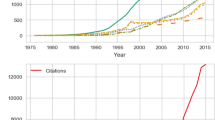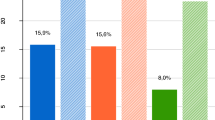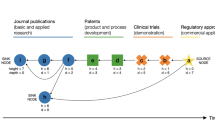Abstract
This paper puts forward a quantitative approach aimed at the understanding of the evolutionary paths of change of emerging nanotechnological innovation systems. The empirical case of the newly emerging zinc oxide one-dimensional nanostructures is used. In line with other authors, ‘problems’ are visualized as those aspects guiding the dynamics of innovation systems. It is argued that the types of problems confronted by an innovation system, and in turn its dynamics of change, are imprinted on the nature of the underlying knowledge bases. The latter is operationalized through the construction of co-citation networks from scientific publications. We endow these co-citation networks with directionality through the allocation of a particular problem, drawn from a ‘problem space’ for nanomaterials, to each network node. By analyzing the longitudinal, structural and cognitive changes undergone by these problem-attached networks, we attempt to infer the nature of the paths of change of emerging nanotechnological innovation systems. Overall, our results stress the evolutionary mechanisms underlying change in a specific N&N subfield. It is observed that the latter may exert significant influence on the innovative potentials of nanomaterials.




Similar content being viewed by others
Notes
1 nm = 1 × 10−9 m.
References
Andersen, M. M. (2007). Knowledge dynamics, technological trajectories and emerging innovation systems—lessons from nanotechnology. Paper presented at the DRUID Summer conference 2007 on appropriability, proximity, routines and innovation, Copenhagen.
Asheim, B. T., & Coenen, L. (2005). Knowledge bases and regional innovation systems: comparing Nordic clusters. Research Policy, 34(8), 1173–1190.
Bonaccorsi, A., & Thoma, G. (2007). Institutional complementarity and inventive performance in nano science and technology. Research Policy, 36(6), 813–831.
Borgatti, S., Everett, M., & Freeman, L. (2002). UCINet 6 for windows: software for social network analysis. Harvard: Analytic Technologies.
Breschi, S., & Malerba, F. (1997). Sectoral innovation systems: technological regimes, schumpeterian dynamics, and spatial boundaries. In C. Edquist (Ed.), Systems of innovation: technologies, institutions and organizations (pp. 130–156). London: Pinter.
Breschi, S., Malerba, F., & Orsenigo, L. (2000). Technological regimes and schumpeterian patterns of innovation. The Economic Journal, 110(463), 388–410.
BSI (2007). British Standards (BSI), Publicly Available Specification (PAS) 136, Terminology for nanomaterials PAS, UK.
Carlsson, B., Jacobsson, S., Holmin, M., & Rickne, A. (2002). Innovation systems: analytical and methodological issues. Research Policy, 31(2), 233–245.
Cobo, M., López-Herrera, A., Herrera-Viedma, E., & Herrera, F. (2011). Science mapping software tools: review, analysis, and cooperative study among tools. Journal of the American Society for Information Science and Technology, 62, 1382–1402.
Consoli, D., & Ramlogan, R. (2008). Out of sight: problem sequences and epistemic boundaries of medical know-how on glaucoma. Journal of Evolutionary Economics, 18(1), 31–56.
Cozzens, S., Gatchair, S., Kang, J., Kim, K.-S., Lee, H. J., Ordonez, G., et al. (2010). Emerging technologies: quantitative identification and measurement. Technology Analysis & Strategic Management, 22(3), 361–376.
Darby, M. R., & Zucker, L. G. (2003). Grilichesian breakthroughs: inventions of methods of inventing and firms entry in nanotechnology. NBER Working Paper 9825.
Dosi, G. (1982). Technological paradigms and technological trajectories: a suggested interpretation of the determinants and directions of technical change. Research Policy, 11(3), 147–162.
Dosi, G. (1988). Sources, procedures, and microeconomic effects of innovation. Journal of Economic Literature, 26(3), 1120–1171.
Gee, S., & McMeekin, A. (2011). Eco-innovation systems and problem sequences: the contrasting cases of US and Brazilian biofuels. Industry and Innovation, 18(3), 301–315.
Grupp, H. (1990). The concept of entropy in scientometrics and innovation research. Scientometrics, 18(3), 219–239.
Hekkert, M. P., van Giessel, J.-F., Ros, M., Wietschel, M., & Meeus, M. T. H. (2005). The evolution of hydrogen research: is Germany heading for an early lock-in? International Journal of Hydrogen Energy, 30(10), 1045–1052.
Huang, C., Notten, A., & Rasters, N. (2011). Nanoscience and technology publications and patents: a review of social science studies and search strategies. The Journal of Technology Transfer, 36(2), 145–172.
Hughes, T. (1987). The evolution of large technological systems. In W. E. Bijker, T. P. Hughes, & T. J. Pinch (Eds.), The social construction of technological systems (pp. 51–82). Cambridge: MIT Press.
Jacobsson, S., & Johnson, A. (2000). The diffusion of renewable energy technology: an analytical framework and key issues for research. Energy Policy, 28(9), 625–640.
Kuhn, T. S. (1996). The structure of science revolutions (3rd edn). Chicago: The University of Chicago Press.
Larsen, K. (2008). Knowledge network hubs and measures of research impact, science structure, and publication output in nanostructured solar cell research. Scientometrics, 74(1), 123–142.
Lieber, C. M., & Wang, Z. L. (2007). Functional nanowires. MRS Bulletin, 32(2), 99–108.
Linton, J. D., & Walsh, S. T. (2008). A theory of innovation for process-based innovations such as nanotechnology. Technological Forecasting and Social Change, 75(5), 583–594.
Marshakova, I. (1973). System of documentation connections based on references (SCI). Nauchno-Tekhnicheskaya Informatsiya Seriya, 2(6), 3–8.
Metcalfe, S. (1995). Technology systems and technology policy in an evolutionary framework. Cambridge Journal of Economics, 19(1), 25–46.
Metcalfe, J. S., James, A., & Mina, A. (2005). Emergent innovation systems and the delivery of clinical services: the case of intra-ocular lenses. Research Policy, 34(9), 1283–1304.
Meyer, M. (2007). What do we know about innovation in nanotechnology? Some propositions about an emerging field between hype and path-dependency. Scientometrics, 70(3), 779–810.
Mina, A. (2009). The emergence of new knowledge, market evolution and the dynamics of micro-innovation systems. Economics of Innovation and New Technology, 18(5), 447–466.
Mina, A., Ramlogan, R., Tampubolon, G., & Metcalfe, J. S. (2007). Mapping evolutionary trajectories: applications to the growth and transformation of medical knowledge. Research Policy, 36(5), 789–806.
Mirkin, C. A., & Tuominen, M. (2011). Synthesis, processing, and manufacturing of components, devices, and systems. In M. C. Roco, C. A. Mirkin, & M. C. Hersam (Eds.), Nanotechnology research directions for societal needs in 2020. Berlin: Springer.
Miyazaki, K. (1994). Search, learning and accumulation of technological competences: the case of optoelectronics. Industrial and Corporate Change, 3(3), 631–654.
Miyazaki, K., & Islam, N. (2007). Nanotechnology systems of innovation—an analysis of industry and academia research activities. Technovation, 27(11), 661–675.
Moed, H. F. (2005). Citation analysis in research evaluation. Dordrecht: Springer.
Nelson, R. R. (2003). On the uneven evolution of human know-how. Research Policy, 32(6), 909–922.
Nelson, R. R., & Winter, S. G. (1982). An evolutionary theory of economic change. Cambridge: Harvard University Press.
Nightingale, P., Morgan, M., Rafols, I., & van Zwanenberg, P. (2008). Nanomaterials innovation systems: their structure, dynamics, and regulation. Report for the Royal Commission on Environmental Pollution. Brighton: SPRU.
Noyons, E. (2001). Bibliometric mapping of science in a science policy context. Scientometrics, 50(1), 83–98.
Parayil, G. (1991). Technological change as a problem-solving activity. Technological Forecasting and Social Change, 40(3), 235–247.
Persson, O. (1994). The intellectual base and research fronts of JASIS 1986–1990. Journal of the American Society for Information Science, 45(1), 31–38.
Pitkethly, M. J. (2004). Nanomaterials—the driving force. Materials Today, 7(12), 20–29.
Porter, A. L., & Cunningham, S. W. (2005). Tech mining—exploiting new technologies for competitive advantage. Hoboken: Wiley.
Porter, A. L., Roessner, J. D., Jin, X.-Y., & Newman, N. C. (2002). Measuring national ‘emerging technology’ capabilities. Science and Public Policy, 29(3), 189–200.
Rafols, I., & Meyer, M. (2010). Diversity and network coherence as indicators of interdisciplinarity: case studies in bionanoscience. Scientometrics, 82(2), 263–287.
Rosenberg, N. (1969). The direction of technological change: inducement mechanisms and focusing devices. Economic Development and Cultural Change, 18(1), 1–24.
Sahal, D. (1985). Technological guideposts and innovation avenues. Research Policy, 14(2), 61–82.
Schmidt, J. C. (2007). Knowledge politics of interdisciplinarity. Specifying the type of interdisciplinarity in the NSF’s NBIC scenario. Innovation: The European Journal of Social Science Research, 20(4), 313–328.
Shapira, P., Youtie, J., & Porter, A. L. (2010). The emergence of social science research on nanotechnology. Scientometrics, 85(2), 595–611.
Shea, C. M. (2005). Future management research directions in nanotechnology: a case study. Journal of Engineering and Technology Management, 22(3), 185–200.
Small, H. (1973). Co-citation in the scientific literature: a new measure of the relationship between two documents. Journal of the American Society for Information Science, 24(4), 265–269.
Small, H., & Greenlee, E. (1986). Collagen research in the 1970s. Scientometrics, 10(1), 95–117.
Smith, K. H. (2002). What is the ‘knowledge economy’? Knowledge intensity and distributed knowledge bases. Discussion Paper Series #3 of the Institute for New Technologies. Maastricht: United Nations University.
Verbeek, A., Debackere, K., Luwel, M., & Zimmermann, E. (2002). Measuring progress and evolution in science and technology—I: the multiple uses of bibliometric indicators. International Journal of Management Reviews, 4(2), 179–211.
Wasserman, S., & Faust, K. (2009). Social network analysis: methods and applications. New York: Cambridge University Press.
Wonglimpiyarat, J. (2005). The nano-revolution of Schumpeter’s Kondratieff cycle. Technovation, 25(11), 1349–1354.
Zuccala, A. (2006). Modeling the invisible college. Journal of the American Society for Information Science and Technology, 57(2), 152–168.
Acknowledgments
The first author wishes to acknowledge financial support from the MEXT scholarship (Ministry of Education, Culture, Sports, Science and Technology, Japan) for carrying out this research. The authors are grateful to the editor and two anonymous reviewers for their thoughtful and constructive comments on earlier versions of this paper. We would also like to thank Prof. Dmitri Golberg (International Center for Materials Nanoarchitectonics MANA at the National Institute for Materials Science NIMS, Tsukuba, Japan) for his invaluable insights into the field of nanomaterials.
Author information
Authors and Affiliations
Corresponding author
Rights and permissions
About this article
Cite this article
Ávila-Robinson, A., Miyazaki, K. Evolutionary paths of change of emerging nanotechnological innovation systems: the case of ZnO nanostructures. Scientometrics 95, 829–849 (2013). https://doi.org/10.1007/s11192-012-0939-7
Received:
Published:
Issue Date:
DOI: https://doi.org/10.1007/s11192-012-0939-7




